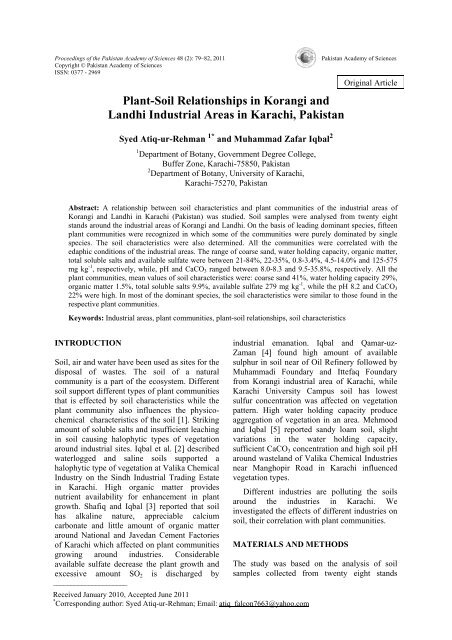Download Full Journal - Pakistan Academy of Sciences
Download Full Journal - Pakistan Academy of Sciences
Download Full Journal - Pakistan Academy of Sciences
- No tags were found...
Create successful ePaper yourself
Turn your PDF publications into a flip-book with our unique Google optimized e-Paper software.
79 Syed Atiq-ur-Rehman and Muhammad Zafar IqbalProceedings <strong>of</strong> the <strong>Pakistan</strong> <strong>Academy</strong> <strong>of</strong> <strong>Sciences</strong> 48 (2): 79–82, 2011Copyright © <strong>Pakistan</strong> <strong>Academy</strong> <strong>of</strong> <strong>Sciences</strong>ISSN: 0377 - 2969Plant-Soil Relationships in Korangi andLandhi Industrial Areas in Karachi, <strong>Pakistan</strong>Syed Atiq-ur-Rehman 1* and Muhammad Zafar Iqbal 21 Department <strong>of</strong> Botany, Government Degree College,Buffer Zone, Karachi-75850, <strong>Pakistan</strong>2 Department <strong>of</strong> Botany, University <strong>of</strong> Karachi,Karachi-75270, <strong>Pakistan</strong><strong>Pakistan</strong> <strong>Academy</strong> <strong>of</strong> <strong>Sciences</strong>Original ArticleAbstract: A relationship between soil characteristics and plant communities <strong>of</strong> the industrial areas <strong>of</strong>Korangi and Landhi in Karachi (<strong>Pakistan</strong>) was studied. Soil samples were analysed from twenty eightstands around the industrial areas <strong>of</strong> Korangi and Landhi. On the basis <strong>of</strong> leading dominant species, fifteenplant communities were recognized in which some <strong>of</strong> the communities were purely dominated by singlespecies. The soil characteristics were also determined. All the communities were correlated with theedaphic conditions <strong>of</strong> the industrial areas. The range <strong>of</strong> coarse sand, water holding capacity, organic matter,total soluble salts and available sulfate were between 21-84%, 22-35%, 0.8-3.4%, 4.5-14.0% and 125-575mg kg -1 , respectively, while, pH and CaCO 3 ranged between 8.0-8.3 and 9.5-35.8%, respectively. All theplant communities, mean values <strong>of</strong> soil characteristics were: coarse sand 41%, water holding capacity 29%,organic matter 1.5%, total soluble salts 9.9%, available sulfate 279 mg kg -1 , while the pH 8.2 and CaCO 322% were high. In most <strong>of</strong> the dominant species, the soil characteristics were similar to those found in therespective plant communities.Keywords: Industrial areas, plant communities, plant-soil relationships, soil characteristicsINTRODUCTIONSoil, air and water have been used as sites for thedisposal <strong>of</strong> wastes. The soil <strong>of</strong> a naturalcommunity is a part <strong>of</strong> the ecosystem. Differentsoil support different types <strong>of</strong> plant communitiesthat is effected by soil characteristics while theplant community also influences the physicochemicalcharacteristics <strong>of</strong> the soil [1]. Strikingamount <strong>of</strong> soluble salts and insufficient leachingin soil causing halophytic types <strong>of</strong> vegetationaround industrial sites. Iqbal et al. [2] describedwaterlogged and saline soils supported ahalophytic type <strong>of</strong> vegetation at Valika ChemicalIndustry on the Sindh Industrial Trading Estatein Karachi. High organic matter providesnutrient availability for enhancement in plantgrowth. Shafiq and Iqbal [3] reported that soilhas alkaline nature, appreciable calciumcarbonate and little amount <strong>of</strong> organic matteraround National and Javedan Cement Factories<strong>of</strong> Karachi which affected on plant communitiesgrowing around industries. Considerableavailable sulfate decrease the plant growth andexcessive amount SO 2 is discharged byindustrial emanation. Iqbal and Qamar-uz-Zaman [4] found high amount <strong>of</strong> availablesulphur in soil near <strong>of</strong> Oil Refinery followed byMuhammadi Foundary and Ittefaq Foundaryfrom Korangi industrial area <strong>of</strong> Karachi, whileKarachi University Campus soil has lowestsulfur concentration was affected on vegetationpattern. High water holding capacity produceaggregation <strong>of</strong> vegetation in an area. Mehmoodand Iqbal [5] reported sandy loam soil, slightvariations in the water holding capacity,sufficient CaCO 3 concentration and high soil pHaround wasteland <strong>of</strong> Valika Chemical Industriesnear Manghopir Road in Karachi influencedvegetation types.Different industries are polluting the soilsaround the industries in Karachi. Weinvestigated the effects <strong>of</strong> different industries onsoil, their correlation with plant communities.MATERIALS AND METHODS−−−−−−−−−−−−−−−−−−−−−Received January 2010, Accepted June 2011* Corresponding author: Syed Atiq-ur-Rehman; Email: atiq_falcon7663@yahoo.comThe study was based on the analysis <strong>of</strong> soilsamples collected from twenty eight stands
















